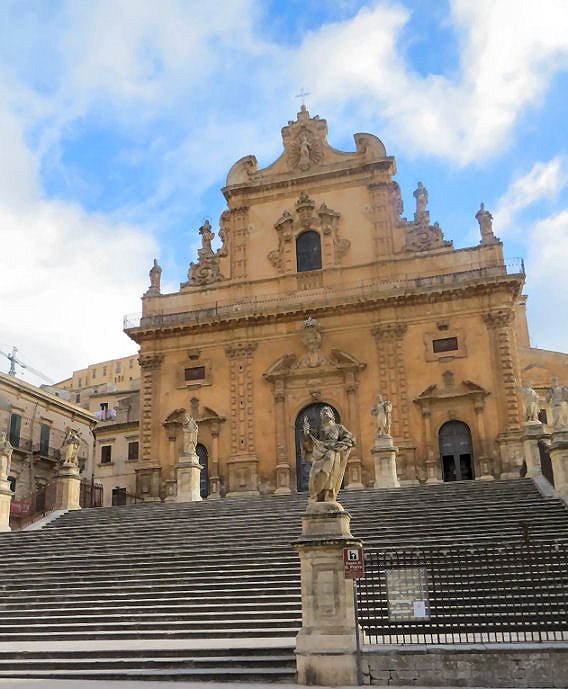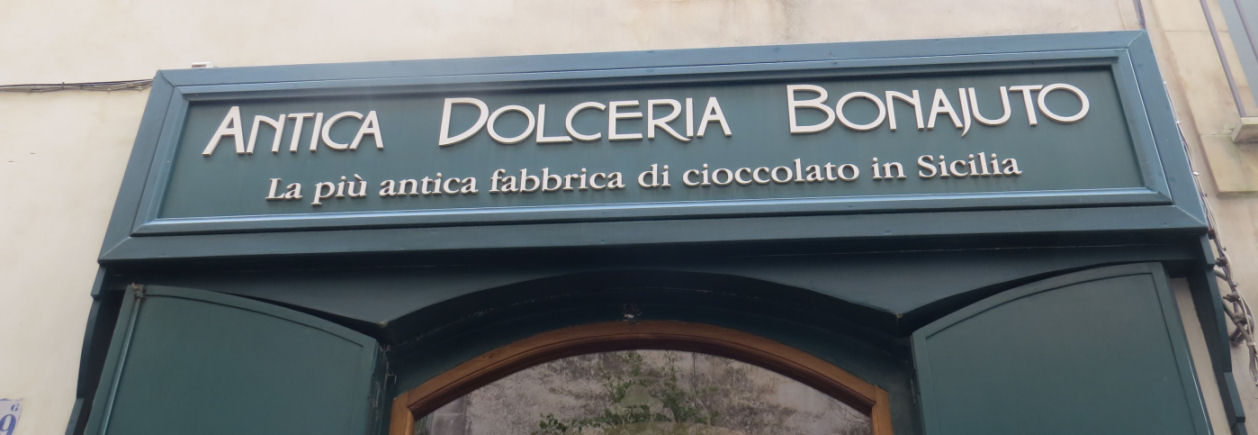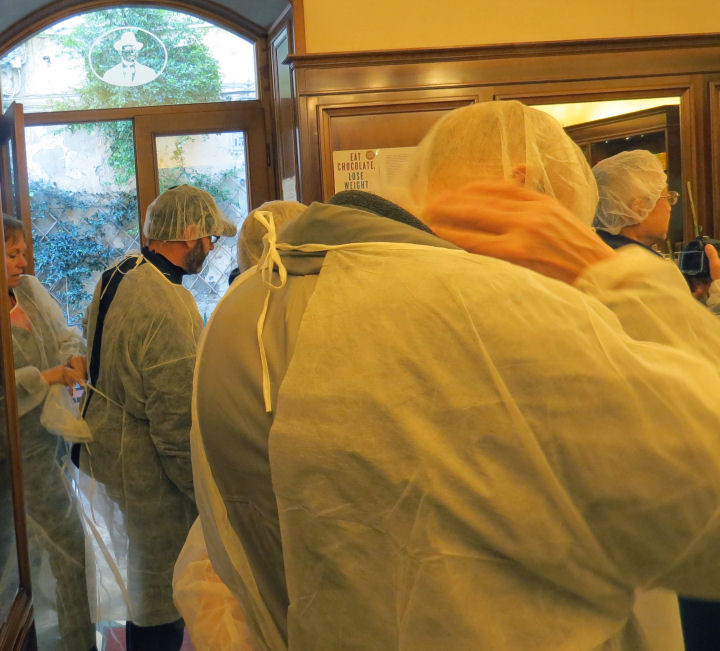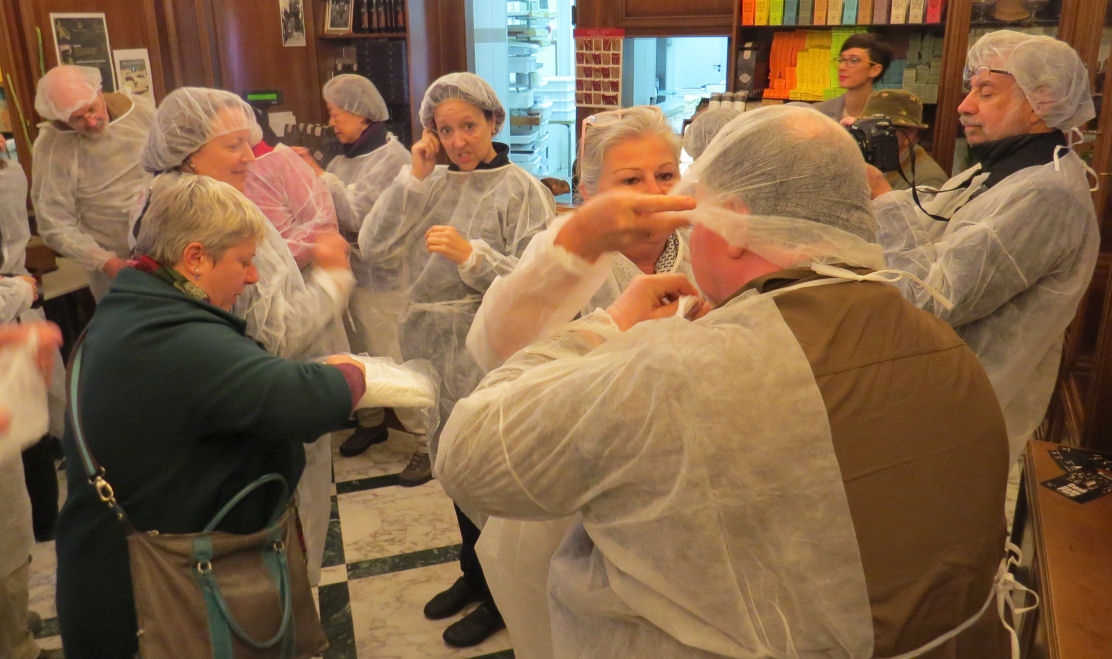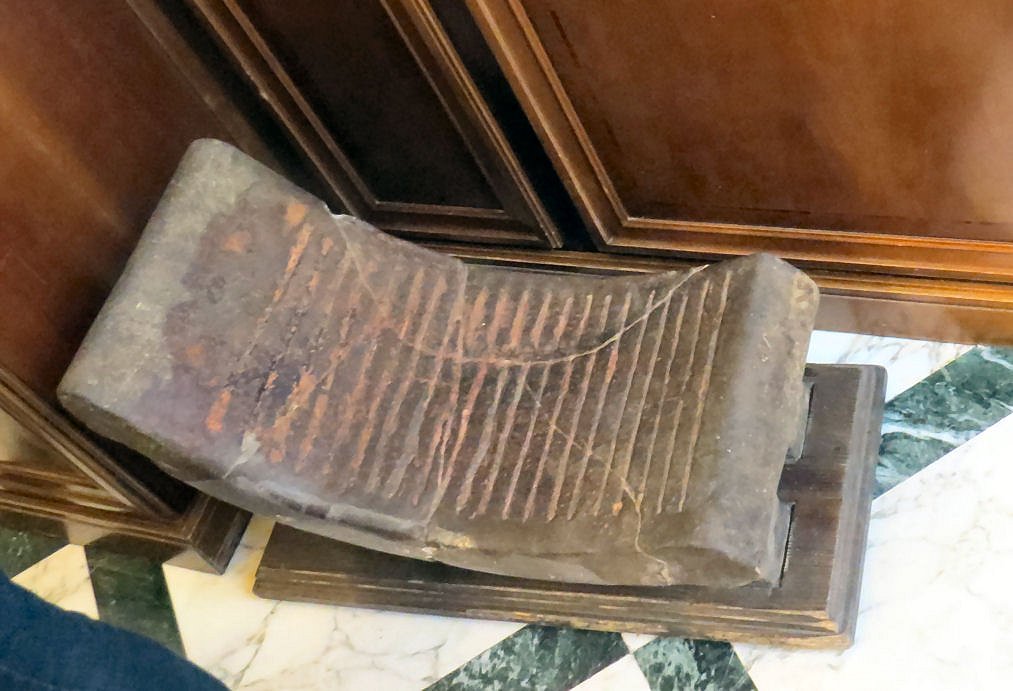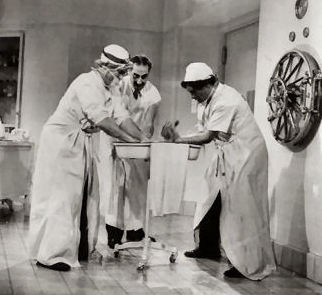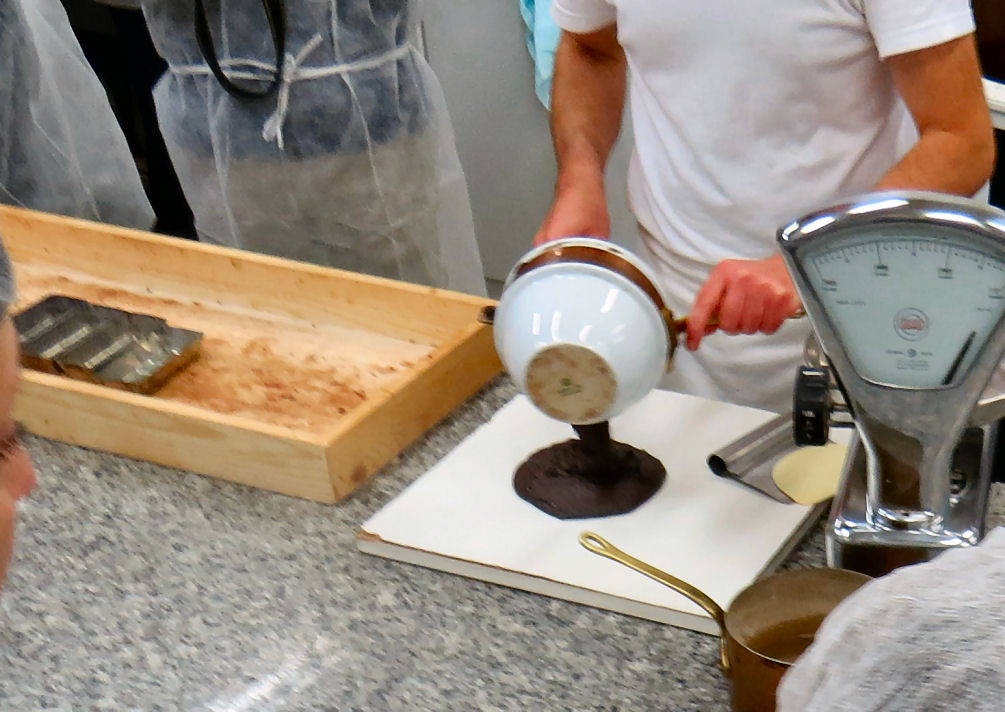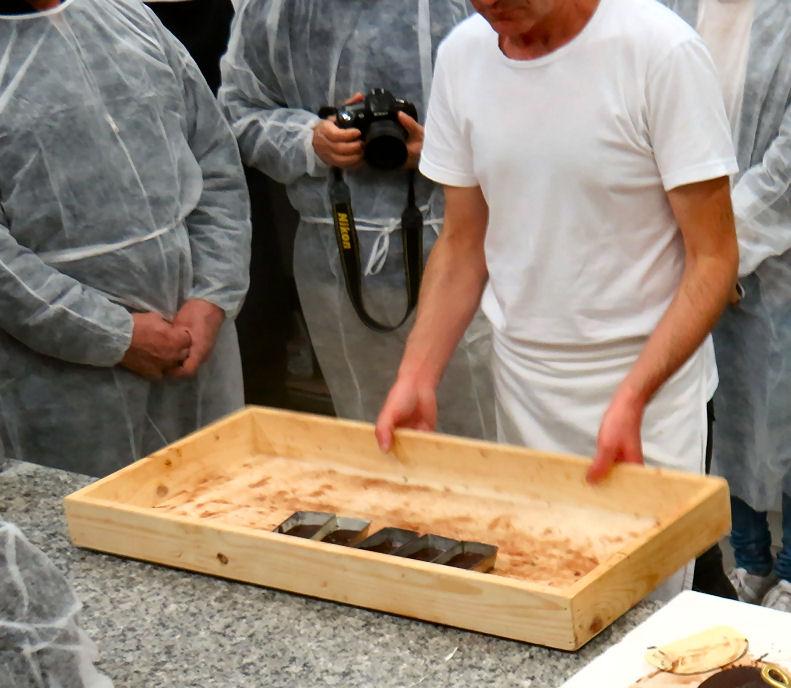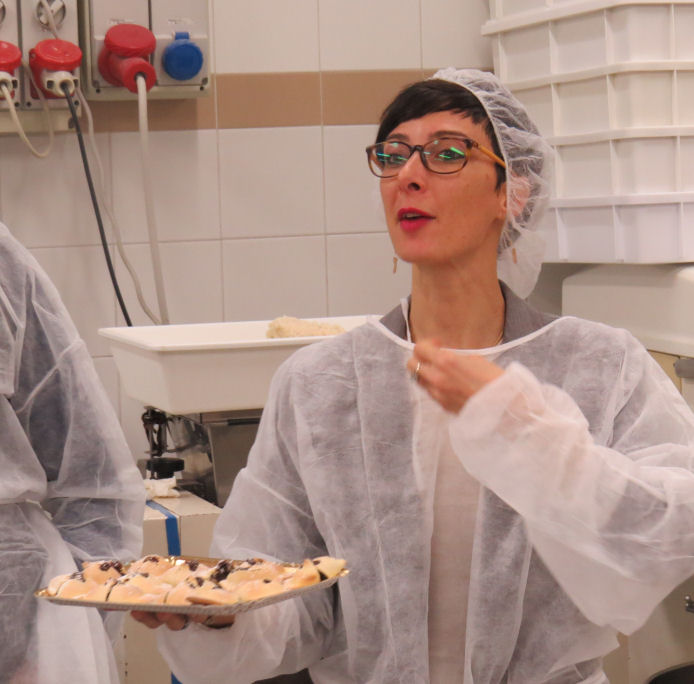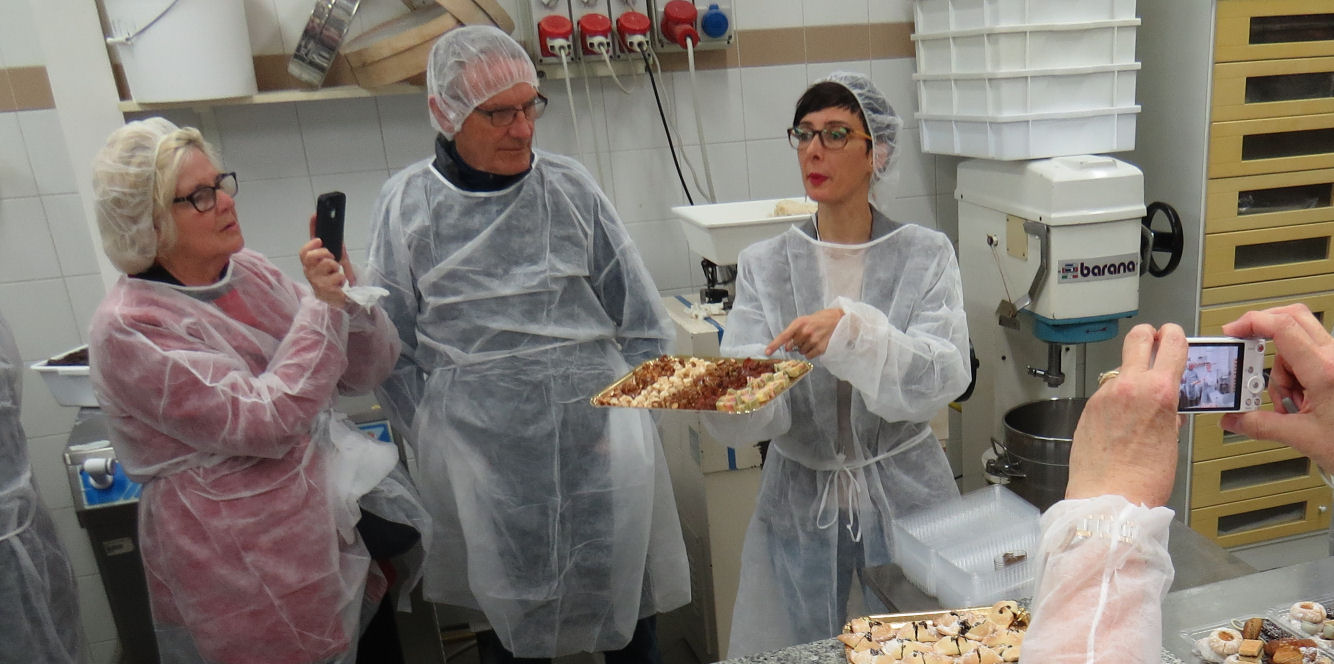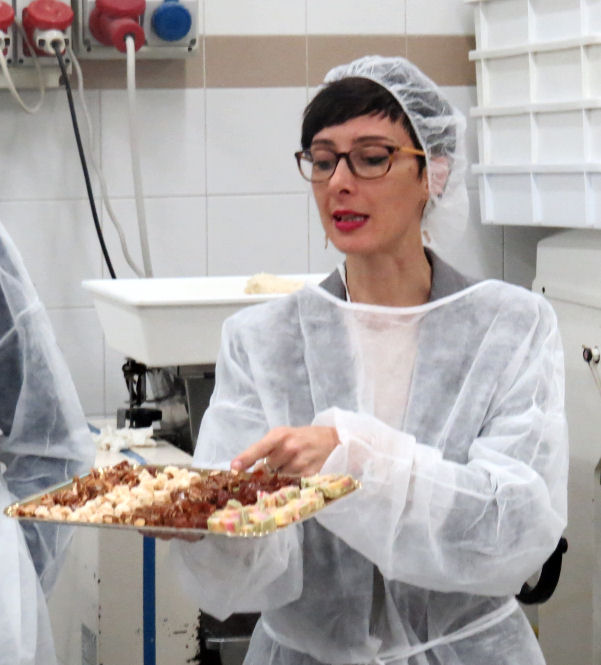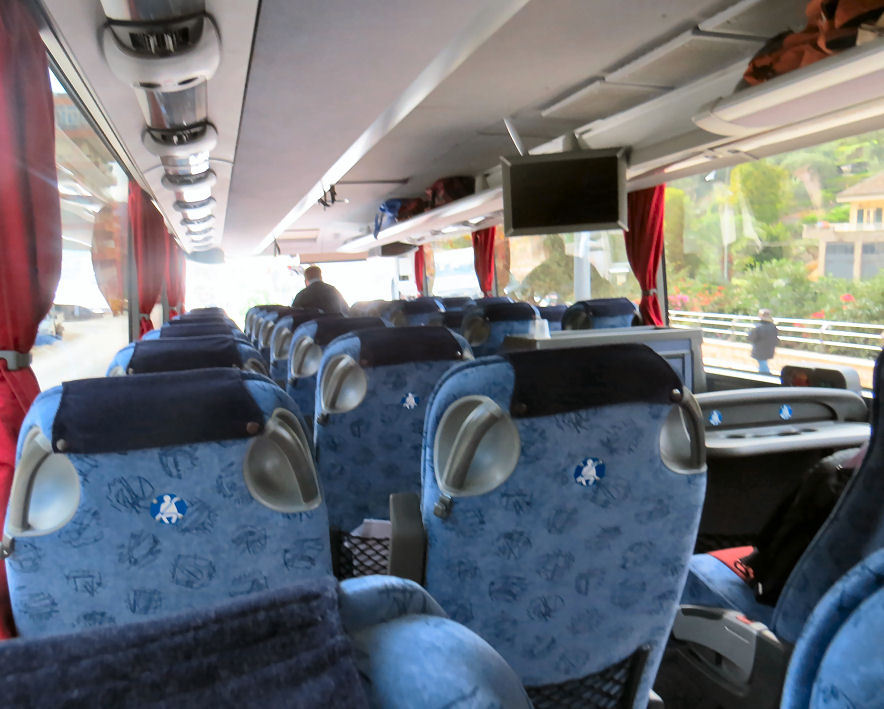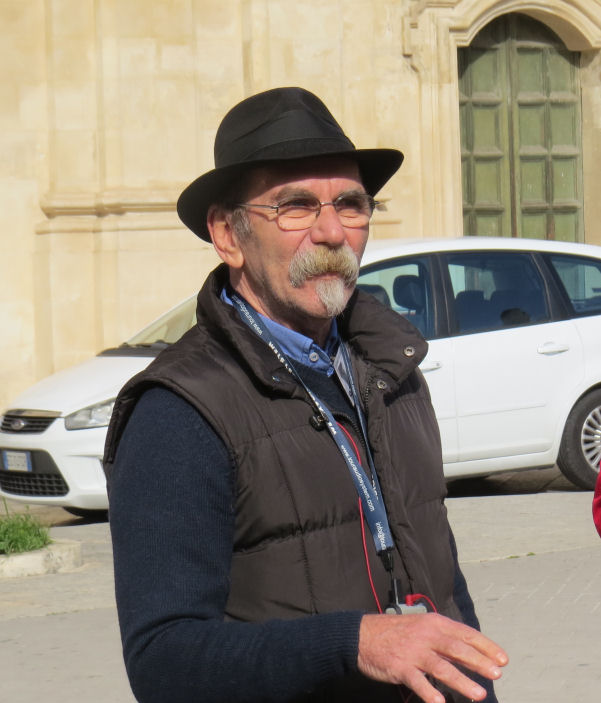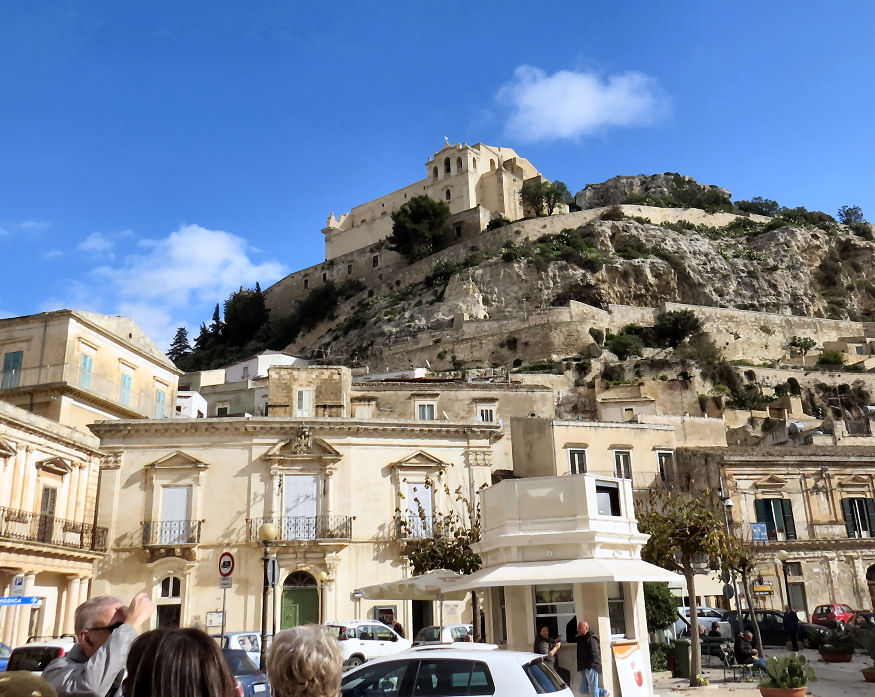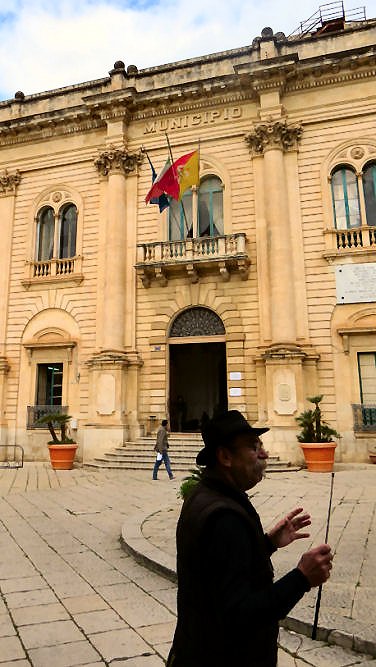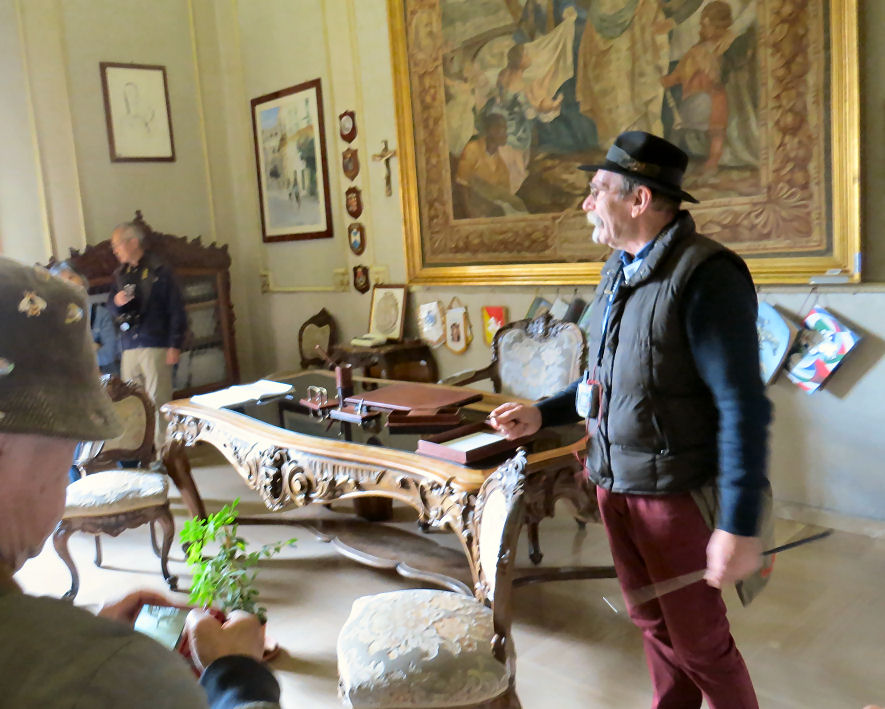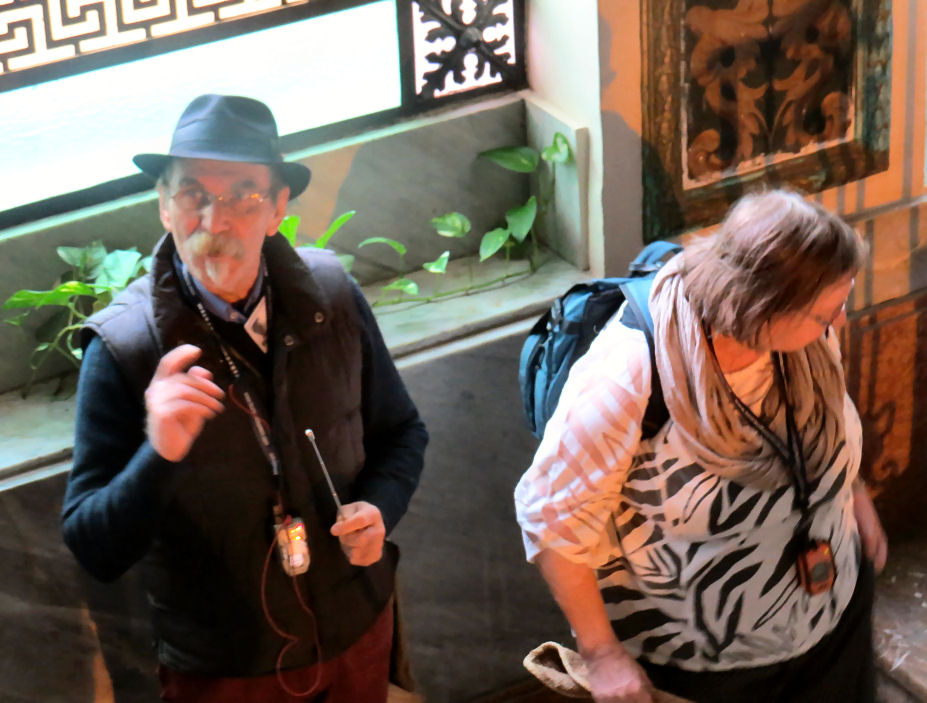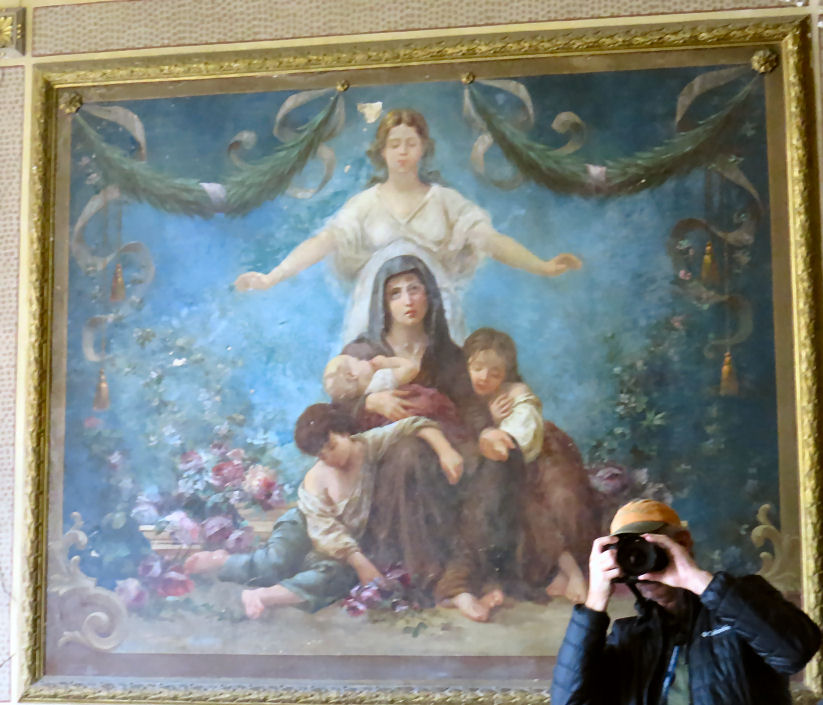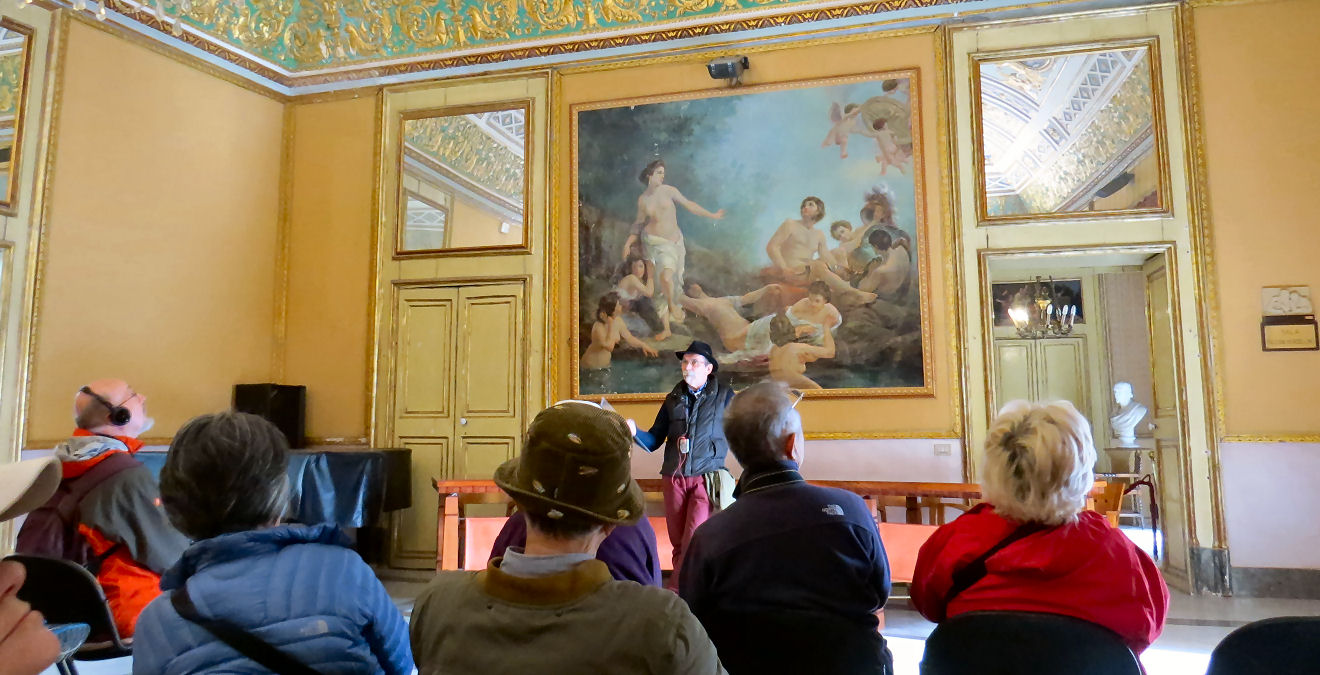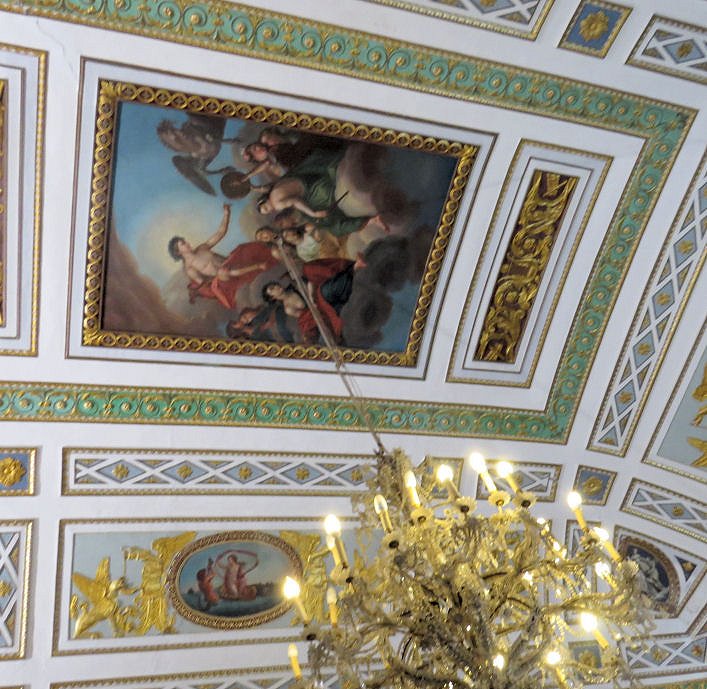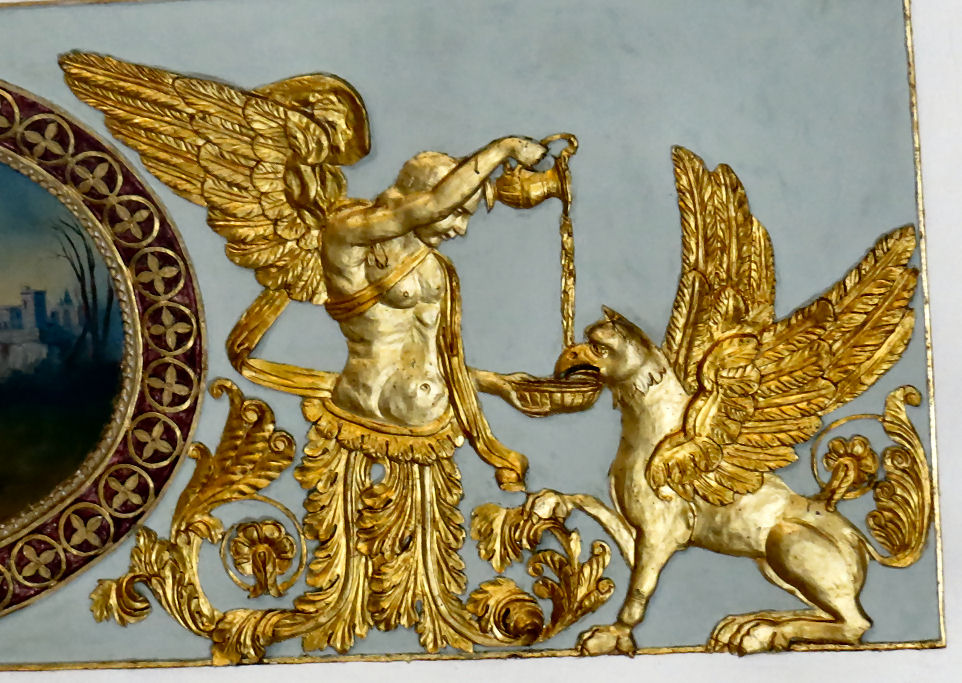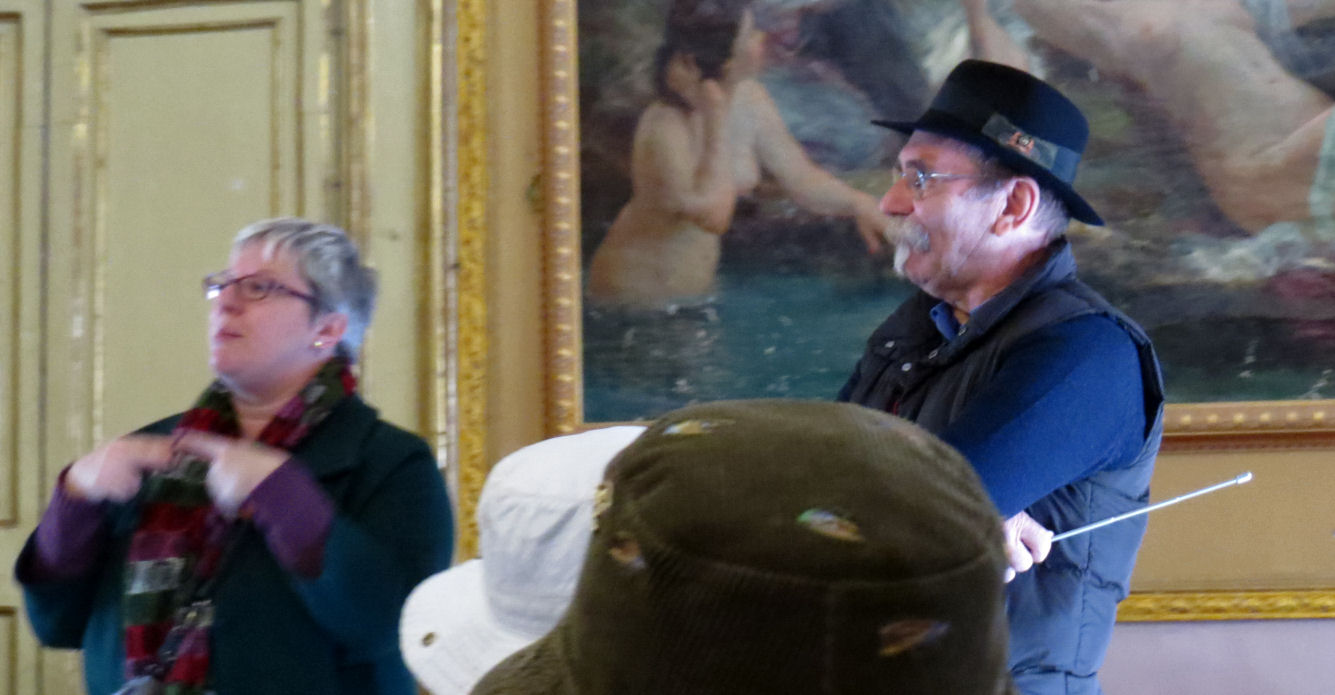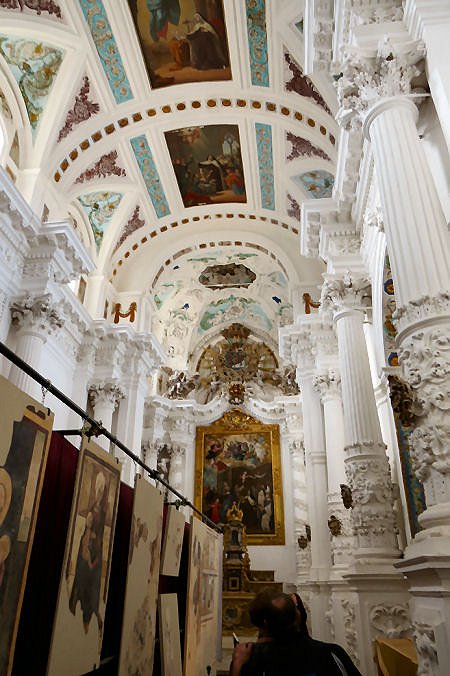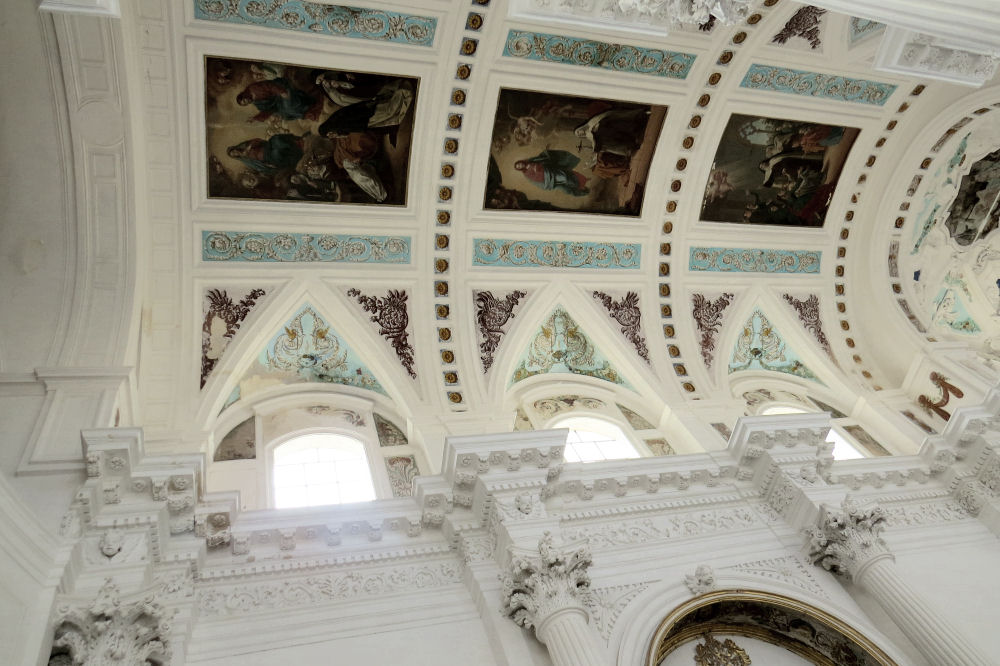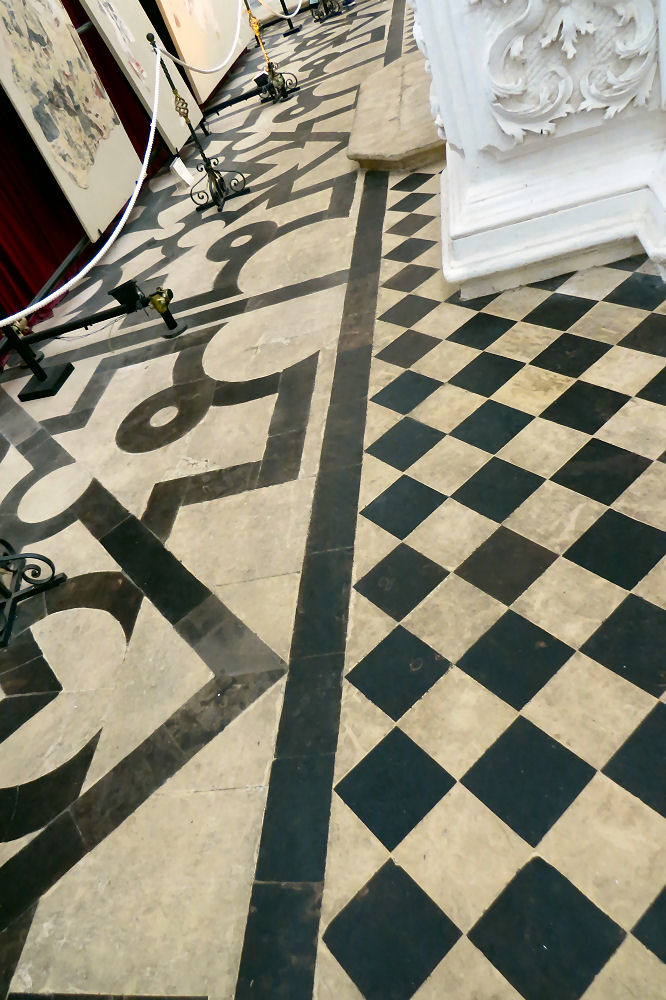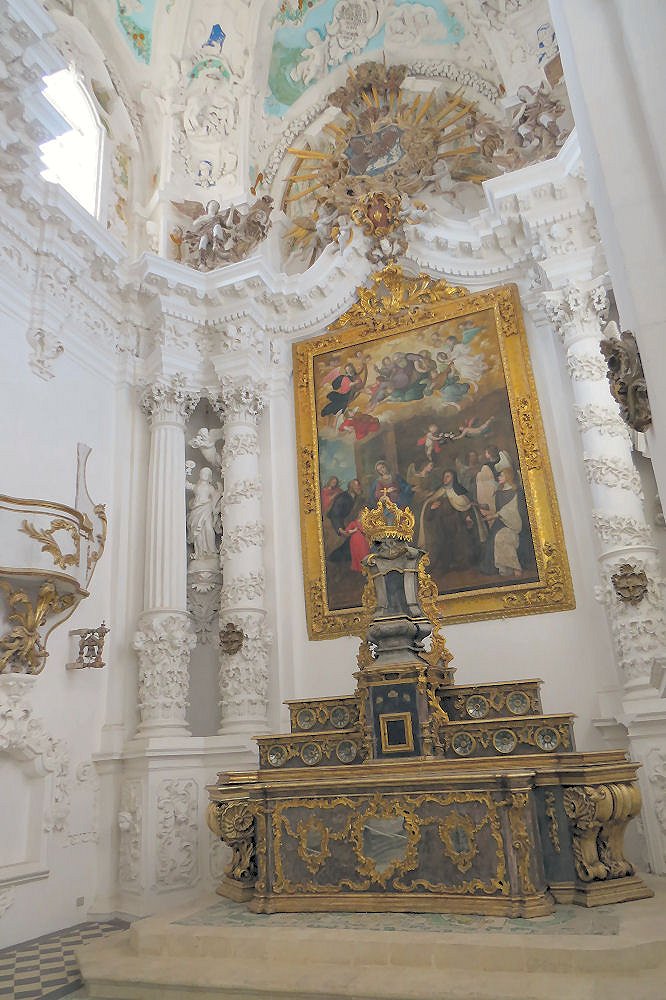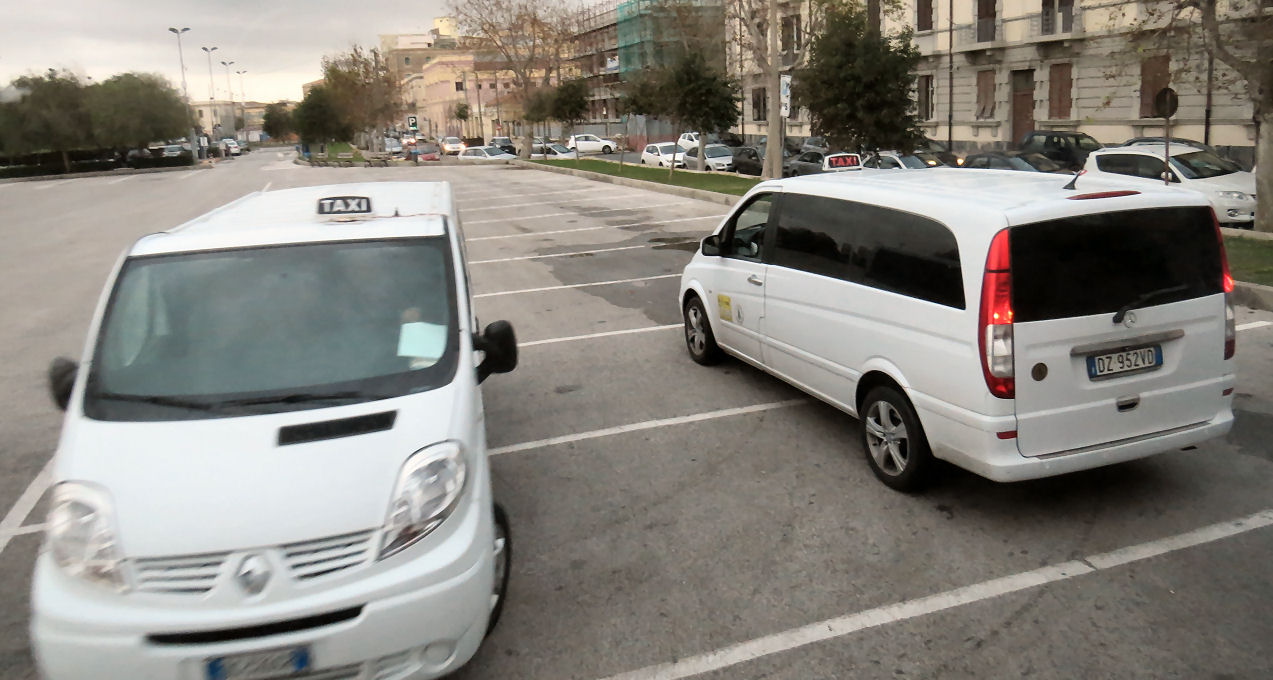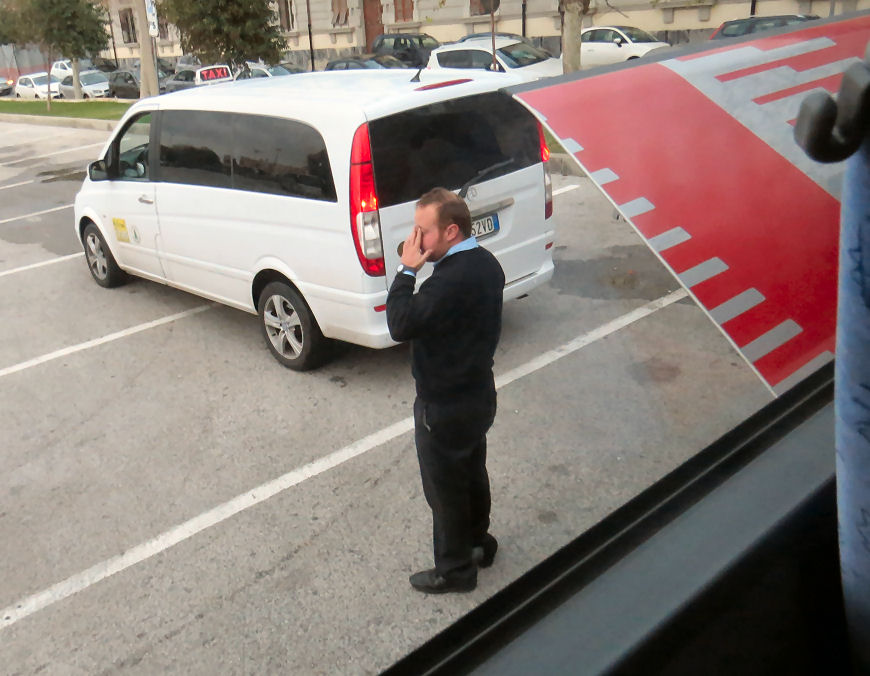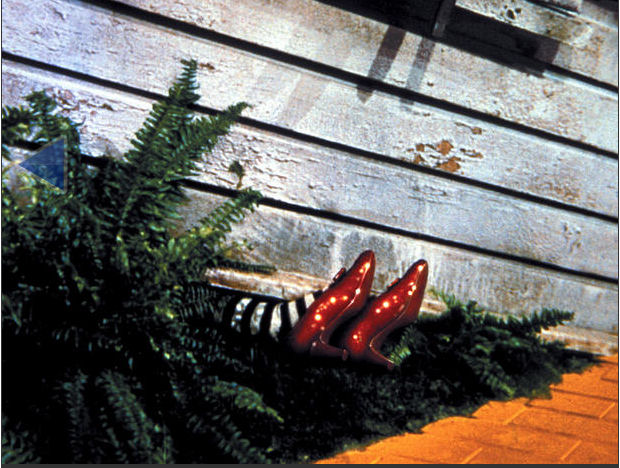
I slept through the night until 6:30 a.m. I felt a little better. My coughing was much less bothersome than on the previous day. However, I was getting low on both acetaminophen and cough drops.
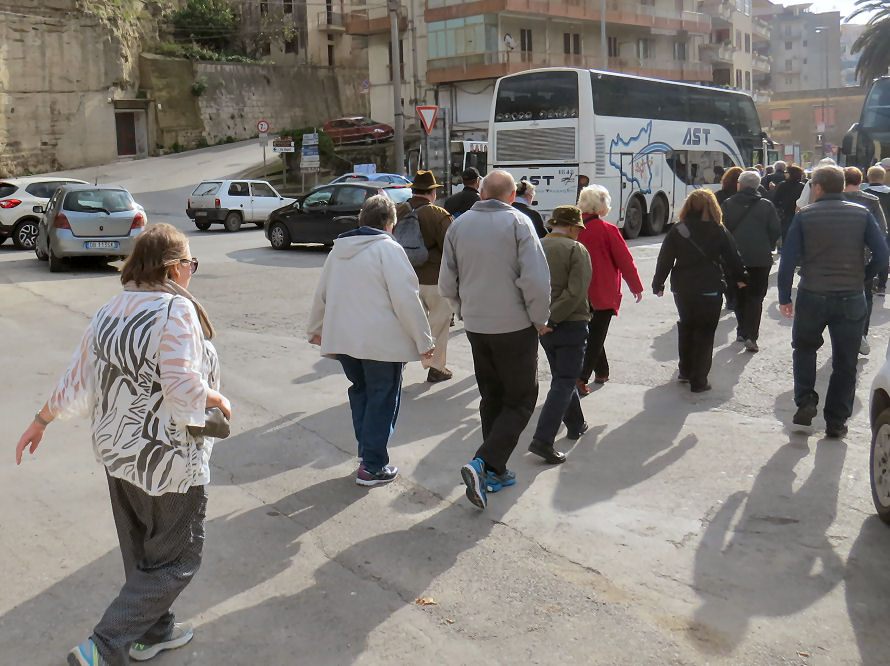
My underwear and socks were dry, but the tee shirts were still a little damp. I put them in the outside compartment of my suitcase. I also packed a little more of Sue's stuff there so that she could close her bag more easily. She wheeled it to the reception desk before breakfast.
The breakfast room was a madhouse. The whole group came at 7:30 in order to make Susanna's deadline of an 8:30 departure. The diners outnumbered the seats, and the line at the bar was ridiculous. Sue tried to get a cappuccino. She returned to the table with it fifteen minutes later.
The owner of the Hotel dell'Orologio asked us for reviews on TripAdvisor. That probably was a mistake. I did not hear any grumbling, but I would be surprised if the other members of the group liked it much better than I did. I considered it by far the worst of the tour's lodgings. It had atmosphere, but that was, in my opinion, its only attraction. Maybe I was just in a bad mood because of my cold and the distressing news on Sunday.
The schedule for this day called for us to make two stops on our way to our ultimate destination of Siracusa.[1]
The first stop was to be in Modica, a town that had mostly been destroyed in the earthquake of 1693. Our plan was to visit a family-owned chocolate factory that had a unique way of making chocolate at relatively low temperatures. It had been run by the Bonajuto family for a very long time. In fact, having been founded in 1880, it could boast that it was the oldest chocolate factory in Sicily.Our schedule also called for us to stop in Scicli (SHEE klee). Susanna did not give us very much information about Scicli, but she did tell us a little about our guide there, whose name was Roberto. He was an Italian, but not a native of Sicily. Susanna said that he was something of a character, and she never knew what he was going to say.
On the way to Modica I sat on the wrong side of the bus for taking photos.
Giuseppe had an easy time driving to Modica, until the last mile or so, when he was attempting to guide the vehicle down the switchback to the historic center. At that point we were stuck in bumper-to-bumper traffic that was moving at a crawl. Several cars in front of us going in our direction made U-turns and drove past us the opposite direction. This option was obviously not viable for our huge vehicle on this narrow road. We saw very few other cars going in the other direction through this entire period.
For ten or fifteen minutes the bus inched forward. We went around the bend, and we appeared to reach the outskirts of the town. Then, just as the traffic seemed to be at a dead stop, Giuseppe pulled into a parking space that was just large enough for the bus. Susanna announced that we had at last reached the parking space for buses. We needed to walk the rest of the way.
Shortly thereafter, as we were parading down to the chocolate factory, we saw and heard an ambulance attempt to get through the traffic jam. As usual, the drivers of the cars paid little attention. There was nowhere for them to go.
We all walked down the street more or less as a group. There was no real payoff for trying to be in the front of the line. Even the people at the back, a group that included Sue and me, had to wait outside of the chocolate factory until the proprietors were ready for us.
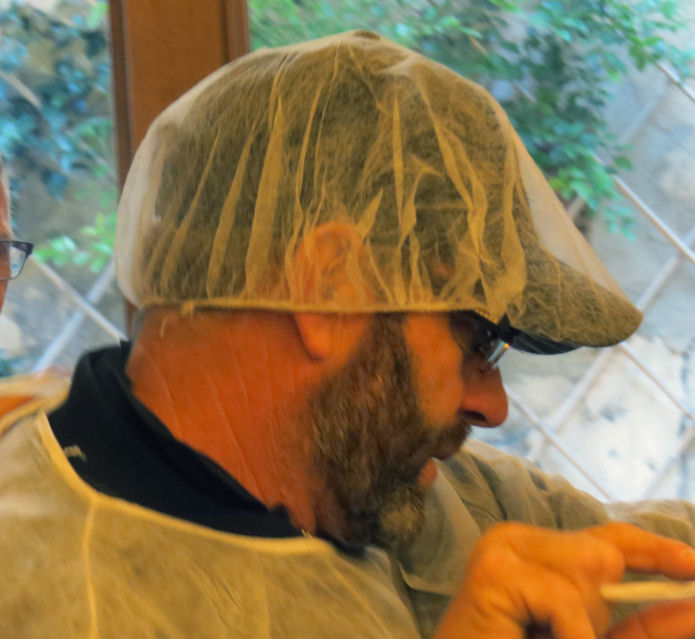
A very elegant lady in red glasses conducted the tour of the factory. I never discovered whether she was an employee or a member of the family.
Her presentation began in the retail area, which was barely large enough to hold our group. She told us that the Bonajuto factory cooked its chocolate at temperatures between 40° and 43° Centigrade, which converts to 104-109.4° Fahrenheit. These were very low when compared with the way that chocolate was made at larger factories.
Our hostess showed us a nineteenth-century implement that was once part of the process. I understood at the time what role it formerly played in the production of their chocolates, but I neglected to write it down in my notes.
For sanitary reasons (I guess) we all were forced to put on ridiculous outfits similar to flimsy hospital gowns. We also got matching hats. I was immediately reminded of Dr. Hackenbush and his two assistants in A Day at the Races. I actually considered asking her if they had a sink where we could get sterilized and compare the quality of our drippings.
No one tied my gown in the back. When we were finally informed that we were done with them, I was the first to doff mine.
We were allowed to sample several little squares of their chocolates. She had warned us that they tasted a little chalky, and she was right. I have never had a sweet tooth, but if I did, I doubt that I would be inclined to mix chalk with my chocolates. Hey—marketing idea: Chalk-olates![2]
We were then allowed to view the chocolate-making process, or at least some semblance of it. An employee poured out some gooey chocolate in a circle. He then used a metallic square to cut it into pieces. The pieces went into rectangular metal containers, which, in turn were placed in a wooden box. He then rhythmically shook the box until the chocolate was evenly distributed in each container. That was the whole process. The lady in the red glasses described what he was doing.
She told us that they offered many different flavors of chocolate, including beef! We were then allowed to sample some hot chocolate that was made with water, not milk. It was much too rich for my blood. The lady then dismissed us so that we would have plenty of time to shop for chocolates.
I had no interest in doing so, and there was no good place to sit in or around the chocolate factory. I therefore immediately started walking back up to the bus, which was parked on the same street as the factory, at a fast pace. There was little danger of getting lost. Sue told me that she was going to take a taxi.
I was quite surprised to see that the massive traffic jam had cleared up completely. There was hardly any traffic at all on Modica's main street, which was named after King Umberto I. I could not name a single store or establishment of any kind on the way back to the bus. I only paused to take a photo of two cars that were parked literally within an inch of one another.
I was the first one to arrive at the bus. Giuseppe let me in. I was just happy to have a comfortable place to sit and work on my journal. Sue decided not to take a taxi, and she managed to leg it to the bus in plenty of time.
When everyone else finally arrived back on the bus, Giuseppe drove us to Scicli, where we were introduced to our local guide, Roberto. He brandished a small baton that he occasionally used for pointing at things.
The entire island of Sicily, according to Roberto, had for many centuries been a predominantly agricultural area. The town of Scicli was founded by the Arabs. It was originally set on the top of the hill.
Roberto asserted that Scicli was a beautiful baroque city. He drew a sharp distinction between Spanish baroque and Sicilian baroque. The Sicilian baroque style developed only after the devastating earthquake of 1693 that affected seventy-seven cities in southeast Sicily and caused seventy thousand deaths.
Afterwards the historic centro was rebuilt over the next one hundred years. The river that ran through what became the center of town was covered over between 1965 and 1975.We then walked over to the city hall, which, we learned, was the stand-in for the police headquarters of the Montalbano movies. One of the offices was used as the place where Montalbano received his assignments from his boss, the police commissioner.
Roberto told us that the series started in 1998, and the first ten films were better than the later ones. The actor who played Montalbano, Luca Zingaretti, was not famous when the series started. The emphasis was on the settings, not the actors or the plots. We went inside the building and he showed us the office. Of course, this meant nothing to any of us. It probably would have been the highlight of the entire tour to many Europeans.
At one time there were five churches in the center of the city. By 2016 there were only three. Roberto told us the history of the development, but I could make no sense of this section of my notes. Sorry.
Of the many conquerors of the Sicilians, Roberto asserted that four of them were good—the Greeks, the Arabs, the Normans, and the Spanish. I think that he meant that they left long-lasting impressions on the island without causing undue suffering to the residents. From what we heard of the Greek tyrants, not many of them could be categorized as “good.”
Roberto also emphasized that Latin was never spoken in this area of Sicily. He said that he only spoke Italian to Sicilians, even though he understood and could speak Sicilian. He then amended that to say that he only spoke Sicilian when he was angry at someone.
When we reached the church of San Michele, Roberto explicated the difference between the Sicilian baroque and the Spanish baroque that he said characterized the churches in Modica. The Sicilian baroque style emphasized life, space, and harmony. It used concave and convex lines. The structures were devoid of statues and ugly faces. Common people were welcomed into the churches and buildings. Spanish architecture, in contrast, was designed to terrify the people into submission.
Someone asked about some prickly pear plants in pots. Roberto told us that in Italian they were called fica d'India.
We then visited the Palazzo Spadaro, which exemplified the Spanish approach. Two staircases led up to the landing on which the Spanish officials transacted business. The paintings on either side made it clear that the poor people were only allowed to use one of the staircases. The other was reserved for the landed nobility.
Inside we were allowed to sit down while Roberto explained that the Spaniards allowed the local people to work the land and sell the produce. However, they were required to give 70 percent of their earnings to the baron.
In this palazzo the green room was for men, the red room was for women, and the yellow room in which we were seated was for parties.
Roberto also told us about the Castello Donnafugata in Ragusa, which had 122 rooms. Roberto said that Baron Arezzo, who was responsible for the railroad to Ragusa, built[3] it to show off his wealth.
Somehow the subject changed to the mafia. Roberto said that throughout Sicily's history almost all civilians were agricultural people who had very close ties to the land. Sometimes five to seven families in an area would form a clan. After the establishment of the republic in 1871 the land was, in theory, split up, but in practice most of the 997 titles were bought by the Masari,[4] the owners of cattle. The previous government was nullified when Sicily was annexed by Italy, but nothing was put in its place. The mafia, which Roberto claimed was an acronym for the name of a union, offered to protect inexperienced shop owners and other individuals for 10 percent of their income.
Roberto explained that there were two kinds of mafia. The local mafia dealt with gambling, women, drugs, and pizzo. The “wide mafia” was associated with the government. To get money one had to agree to a bribe of 20-30 percent.
At this point Susanna added her €.02. She said that the corruption that Roberto described continued until this very day. She cited the example of Giovanni di Mauro, the mayor of Agrigento from 1988 to 1993. In 1992 he was elected to the Chamber of Deputies as a Christian Democrat. He was caught up in the Tangentopoli scandal that toppled Craxi (a Communist) and was convicted on corruption charges. However, he was absolved by the appeals court, and he had recently been elected to the senate. Susanna was very fervent in her denunciation of the “political class” in Italy and said that she no longer even thought of Italy as a democracy. Roberto listened intently while she was orating, and, when asked his opinion, agreed with her.
Roberto said that he liked living in Sicily for two reasons. 1. You don't die of stress. 2. The weather. The island was blessed with 210 days of sunshine per year, and it never was below 20° Centigrade.[5]
We strolled over to the church of Saint Teresa. The outside of the church was very plain. The inside, however, offered a good example of Spanish baroque. The church was not very large by Italian standards, but it took a century to build. Roberto explained that the funding for the church came from the second sons who joined the priesthood because their older brothers stood to inherit the family's land. The families paid the church large fortunes to take these fellows off of their hands. It took three or four generations of these occurrences to pay for all of the construction and the decorations.
The floor of the church was sandstone. Some of the tiles were stained black with oil.
The church had been closed since 1950. The official explanation for this act was that some of the nuns assigned to it had gotten pregnant. Roberto intimated that the real reason was that many of the Spaniards in Scicli had been Freemasons. The decorations of the church included several masonic symbols. The church had always vigorously opposed Freemasonry. Evidently it took the clerical officials a long time to notice the symbols.
Robert said addio to us at that point. He advised us to go into St. Teresa's to admire the interior. Then we could get some lunch on our own. He said that a couple of places appeared to be open. After that the group would meet to walk back to the bus.
I enjoyed Roberto's presentation and Susanna's addendum. They cleared up a few things that I did not previously understand. Roberto's style contained just the right combination of didactic rigor and wry humor for my taste.
The interior of St. Teresa's was very impressive, but it was difficult to photograph. The church was long, but not very wide. In the middle were arrayed posters and barriers that prevented one from walking from one side to the other.
There only seemed to be two places in town to eat. I was in the mood for pizza. The place that was near St. Teresa's did not seem to offer much. So, Sue and I trooped back up to the Millennium Cafe. I had noticed a chalkboard outside of that establishment that advertised it as “ristorante e pizzeria.” We went inside, and they immediately directed us downstairs to a fairly classy dining room. We were the only people there.
The service was absolutely horrendous. While we were looking at menus, most of the rest of the group also came in and were seated. Finally the waiter came to our table. He told us that they never serve pizza[6] at lunch. The choices were to eat something else there or seek out another place. I was frustrated at this development, but the only tenable option seemed to be to find something else on the menu and hope that it was not “finished.” I chose the frutti di mare, which was served on a pasta with a tomato-based sauce. I would have preferred less sauce, but there was no chance of negotiating at this point. I also ordered a large beer. I did not enjoy my meal at all.
Sue had soup and something else. She liked her lunch well enough.
I tried in vain to get several of the staff to bring me the conto. In the end we had to go upstairs to pay. At that point we were once again the only people in the restaurant. I found this process extremely annoying. I got so distracted that I almost left my camera in the restaurant. I would never under any circumstances return to this restaurant for reasons that will soon be obvious.
When we went outside, we were surprised to find that it had grown cloudy and much cooler. The skies looked somewhat threatening. Emily reported that it would rain tonight, but the weather would be good for the rest of the tour.
Giuseppe drove us to Siracusa. Along the way Susanna told us that it was a city of about 130,000 people. The bus would not be able to get us very close to the hotel, which was in the oldest section of the city, known as Ortygia. Instead, we would be transported there in two van-sized cabs that were scheduled to meet us at the parking lot.
Our hotel in Siracusa was a converted convent that had been run by the Ursulines, the same order that had been my teachers at Queen of the Holy Rosary School in Overland Park, KS, and my dad's teachers at a school in Kansas City, KS,[7] as well. I had heard about people staying in convents in Italy, but this was my first such experience. The hotel, which was called Domus Mariae, had scattered cards with religious sayings throughout the room. I found them more hopeful than preachy.
Room #204 was a substantial upgrade from the one in Ragusa. Unfortunately, by the time that we reached the room, I was feeling a little queasy. I lay down on the bed for a rest so that I would be ready to join the group for the orientation trip at six o'clock. After a few minutes of horizontal stillness, I needed to rush to the bathroom where I disposed of half of my lunch in the toilet. I went back to the bed and lay down again. A few minutes later I was sick again.
Sue, as usual, passed on the orientation walk. I was disappointed that I had been too ill to attend. I had been looking forward to coming to this city from the very beginning. It was rated as the #1 attraction on the island by Lonely Planet, and I knew that it had a very long, very rich history. I also wanted to find a farmacia to restock my analgesics and cough drops.
My disappointment was allayed when I learned that it had rained pretty hard that evening. I had my poncho with me at all times on the tour, but I was perfectly content that I had not been required to withdraw it from my backpack.
I ate two packages of bread sticks that Sue had purloined from the restaurant. I also consumed the rest of my cheese doodles and some water. By eight or nine o'clock I felt fine, but I never did get hungry.
Monday only held the title of least enjoyable day on the tour for twenty-four hours. I was beginning to think that perhaps I just did not like Sicily.
I took a shower, which I found quite satisfactory. I also was very appreciative of the pillow.
[1] I opted for the Italian spelling because, as in Mozia, that is how everyone pronounced it.
[2] Unfortunately, it would not work in Italian, and I do not think that the company exports is products. The Italian word for chalk is gesso.
[3] The castle was constructed long before the baron's time, but he dramatically refurbished it in the nineteenth century.


